When you conjure up a mental image of Santa Claus, what do you see? I’d imagine yours resembles mine: a long-bearded, red-robed man flying through the night sky, on a sled towed by a team of magical reindeer. With plenty of devoted elven helpers running about, busily preparing for the annual Christmas Eve deliveries.
This cultural tradition is so embedded in us that the winter and Saint Nick are almost inseparable. The North Pole legend and all the symbolism surrounding it has become such a foundational principle of our seasonal reality that we’ve almost ceased questioning its origins.
Well, in the spirit of sacred curiosity we did a little digging through the archaeological record to find out exactly where and when the “Red One” stepped into our collective reality. This seemingly innocent exercise quickly blew up into a journey across cultures, continents, and millennia. I hope you enjoy the ride!
A quick disclaimer: the findings below are just a theory derived from an abundance of historical documentation we collected. If you believe Santa came from somewhere else, that is your God-given right and we respect that.
Ok, there are so many places to begin. A thousand doorways, you could say… wink, wink. (It’ll make sense later.) I guess the most obvious starting point is an exploration of Santa’s outfit.
The Hat
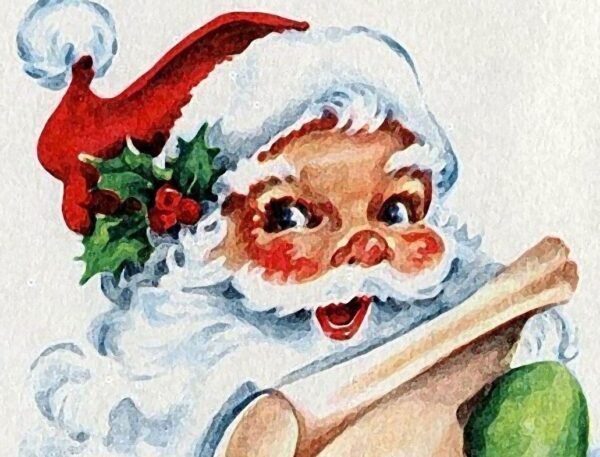 We’ve all worn the fluffy, floppy conical Christmas cap. Santa’s hat is an icon all by itself, bringing back images of childhood hopes and dreams, holiday parties of yesteryear, maybe even painful ghosts of Christmas past. The look and feel of this thing is so etched into our brain that it feels preordained, like it’s always been here waiting for us. But where does it come from?
We’ve all worn the fluffy, floppy conical Christmas cap. Santa’s hat is an icon all by itself, bringing back images of childhood hopes and dreams, holiday parties of yesteryear, maybe even painful ghosts of Christmas past. The look and feel of this thing is so etched into our brain that it feels preordained, like it’s always been here waiting for us. But where does it come from?
The ancient Persian religion of Mithraism. More specifically, the sun god Mithra himself.
(I know – weird, right? Did I just ruin Christmas? I hope not, because we’re just getting warmed up.)
Ok, who is Mithra and how did his fashionable headgear end up on Santa’s head…
Mithra is a messianic (savior) god that was worshipped in Indo-Iranian cultures over 5,000 years ago, and still has millions of followers today. He is a central figure in the Zoroastrian faith and has drawn many comparisons to Jesus, Horus, Krishna, and a few other key spiritual icons throughout human history. He too was born on December 25th, also performed miracles and also had a supernatural birth.
 He has this stylish cap he likes to wear, that looks oddly familiar. The hat – which represents freedom and liberation from servitude – seemed to catch on across multiple civilizations and became a must-have accessory in ancient Roman Saturnalia celebrations around the winter solstice. It was also worn during the Roman festival of Dies Natalis Solis Invicti (Latin for “Birth Of The Invincible Son”)
He has this stylish cap he likes to wear, that looks oddly familiar. The hat – which represents freedom and liberation from servitude – seemed to catch on across multiple civilizations and became a must-have accessory in ancient Roman Saturnalia celebrations around the winter solstice. It was also worn during the Roman festival of Dies Natalis Solis Invicti (Latin for “Birth Of The Invincible Son”)
Here are a couple images of the “Cap Of Mithra,” also known in Turkish tradition as the “Phrygian Cap.” Look familiar?
According to scholar Joshua J. Mark:
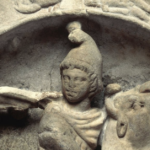 “Mithra is ever-vigilant and cannot be deceived, knowing the hearts and true intentions of people, and keeping the forces of darkness at bay.”
“Mithra is ever-vigilant and cannot be deceived, knowing the hearts and true intentions of people, and keeping the forces of darkness at bay.”
So Mithra sees you when you’re sleeping and knows if you’ve been bad or good… Is there a connection to Santa’s naughty and nice list here? Hey, all I can do is provide the facts – the rest is up to you.
Another thing about Mithra… he always hangs out with his buddy Varuna – the Sky God. They live in a golden castle tucked into the heavens that has 1,000 doors or portals. And get this – they ride through the sky together on a golden chariot… (or sleigh?)
The Robe
If you scour the internet, you’ll find plenty of claims that Santa’s robe is derived from the coat worn by Sami shamans during their forest foraging forays for the treasured Amanita muscaria mushroom (more on this fantastic fungi in a bit). Well, after looking at the anthropological evidence – including direct testimony from the Sami people themselves – we can safely say this is false.
In fact, the comparisons between Sami shamanic dress and Santa are seen by the Sami as culturally insensitive – so make a note, if you ever find yourself in these territories of Sweden, Finland, or Norway.
Far more likely is that Santa’s red coat comes from the Dutch tradition of Sinterklaas (Saint Nicholas) – which is still celebrated today. As the name implies, the festivities of this tradition are meant to celebrate Saint Nicholas, the patron saint of children, the poor, and… prostitutes?
 Sinterklaas has been a midwinter icon in Northern Europe for over 700 years and likely contributed the long red robe that we see hanging on modern-day Santa’s generous frame. The original Saint Nick was also the Bishop of Myra, and wore the traditional red and white garments that were custom in that era of the Catholic Church. The likeness in these side by side photos is too uncanny to ignore.
Sinterklaas has been a midwinter icon in Northern Europe for over 700 years and likely contributed the long red robe that we see hanging on modern-day Santa’s generous frame. The original Saint Nick was also the Bishop of Myra, and wore the traditional red and white garments that were custom in that era of the Catholic Church. The likeness in these side by side photos is too uncanny to ignore.
The Beard
At a glance, you might say that Santa’s bushy white beard clearly came from Sinterklaas too. But examine the beard in these photos – one is modern day Sinterklaas and one is a famous mosaic / painting of Saint Nicholas himself.


The ancient guy’s beard is a little underwhelming, is it not?
Now let’s look at the beard of the Norse god Odin (Zeus-type figure), who is often depicted riding through the sky on his 8-legged horse, delivering presents to children during the pagan midwinter festival of Yule. And who was long worshipped in the same region of the world as Sinterklaas.

Looks pretty familiar right? When you imagine that paganism – which simply means “non-christian” – existed across Europe and the rest of the world well before the Roman Catholic Church got there, it’s only logical that aspects of the old gods would merge with the new.
We see this all the time in other indigenous traditions worldwide. The Catholic church gets to the Amazon and forces the locals to comply with their beliefs – or else they are slaughtered or enslaved. For the sake of survival the native people outwardly fall into line, but what happens to the millennia-old jungle gods that the tribes have been worshipping up until this hostile colonization occurs?
The people begin to secretly overlay those old gods (and the mystical forces and powers they carry) onto the new gods, angels, and saints that they are now being told to recognize. Yes, Central and South America are very religious regions – but look closer into the more remote territories tucked in the jungle or high in the mountains and you will often witness ancient indigenous myths and legends being worshipped under the guise of these biblical characters.
So, the robe came from Saint Nicholas and the beard was likely transposed onto Nick’s face as an ode to the prevailing Norse god Odin (who, again, also likes to fly through the night sky with goodies for the kiddos.)
The Entourage
In most portrayals of Santa, there are a whole cast of characters that have his back. These usual suspects can be broken down into two magical species – elves and flying reindeer.
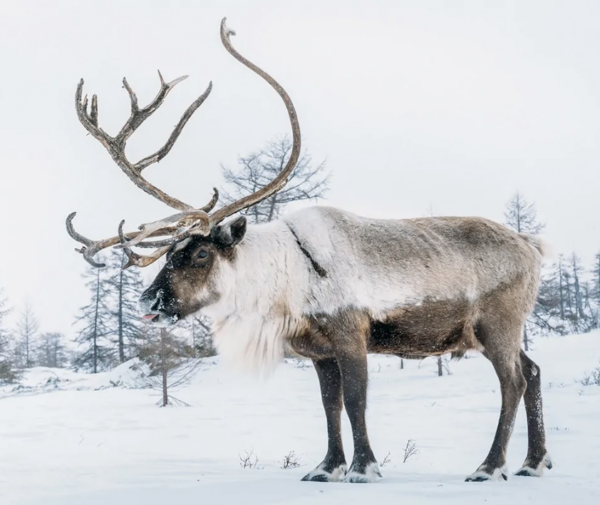 This is probably where the first a-ha moments of the Christmas / Shamanism comparison began. Let’s start with the reindeer.
This is probably where the first a-ha moments of the Christmas / Shamanism comparison began. Let’s start with the reindeer.
In the boreal forests of the Siberian Steppe, the reindeer is one of the most relied-upon and culturally significant animals, from both a practical and a sacred perspective. It takes a lot of grit to survive in harsh northern climates and these robust and easily trained animals seem to be born for it. They are a means of transportation, food, clothing, and also… sidekicks on the shaman’s journey into realms of psychedelia.
You see, many shamans of this region utilize the entheogenic properties of a specific mushroom known as Amanita muscaria to induce visions and access other planes of existence – usually to heal the sick, aid loved ones in their transition to the the afterlife, or exorcise bad spirits from the possessed. The catch is that eating or drinking straight Amanita is a very bad thing for your health. It can cause blindness, brain damage, coma, and even kill.
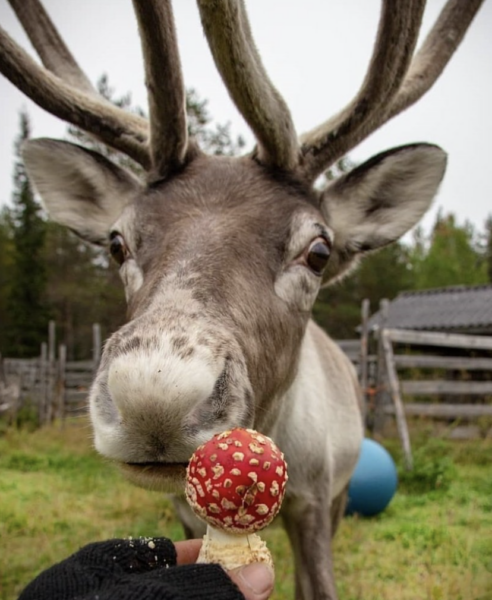 Fortunately, the local Siberian reindeer consider these mushrooms a delicacy and eat them by the dozens when given the opportunity. This is a huge help to the Siberian shaman, who utilizes these hearty four-legged friends as living filters to make the Amanita safe to drink.
Fortunately, the local Siberian reindeer consider these mushrooms a delicacy and eat them by the dozens when given the opportunity. This is a huge help to the Siberian shaman, who utilizes these hearty four-legged friends as living filters to make the Amanita safe to drink.
The harmful mycological toxins seem to be no problem for the reindeer, whose organs naturally filter and dispose of the poison before excreting the rest in their solids and fluids. Their urine is collected like a precious nectar by the Reindeer people because it contains trace amounts of the psychedelic compound that can be safely drunk during ceremony or celebration.
The sages of this region speak of witnessing reindeer “fly” among the stars while both shaman and beast are high on the Amanita muscaria… Is this where the first sightings of comet, cupid, and co. occurred?
On to the Elves. If you have ever worked with Tryptomine-containing plants, fungi, or toad venom, there’s a good chance that you have “seen things” that are hard to unsee. Within these extraordinary realms of consciousness, many report seeing busy and purposeful “builder-beings” (my own term) that look almost like extraterrestrial Fraggle Rock characters. They sing and comment and poke fun and show you things… sometimes meaningful metaphysical patterns, sometimes your biggest blindspots, sometimes absolute nonsense.
Before ever working with a sacred plant that is unfamiliar to you I highly recommend checking out the trip reports from seekers like yourself on Erowid.org – it’s one of the coolest websites I’m aware of. Reading through these psychonaut journal entries, you will see a common theme among those who have taken both psilocybin mushrooms and Amanita muscaria.
Simply put – folks report seeing elves. But don’t take my word for it – below is a first-person account of this phenomenon from perhaps the most beloved psychonaut who ever lived. The eminent Terence McKenna.

The Tree
We conclude our holiday investigation with perhaps the most conspicuous – albeit heartwarming and nostalgic – Christmas tradition of them all. The Christmas tree.
Somewhere along the evolutionary line, a large swath of Homo sapiens living the Northern Hemisphere decided it would be a good idea to cut down an evergreen tree each winter, place it in the center of their home, string ornamentation around it, and mount a pile of carefully wrapped gifts underneath.
There are many theories as to where this practice originated, ranging from the apple-adorned evergreen in the ancient “Paradise Play,” a medieval performance of Genesis 3 (the fall of Adam and Eve), to the Roman use of evergreen branches to decorate temples during the midwinter holiday of Saturnalia. None of these, however, seems to encapsulate the full scope of what we see on Christmas as much as the Siberian Santa connection.
Shamans from the Uralic-speaking areas of western Siberia as well as the Paleosiberian-speaking regions of the Far East sometimes keep an evergreen tree in the center of their hut or yurt. This is seen as a living symbol of the cosmic World Tree, an interdimensional motif that connects the spirits of the heavens, the living beings on earth, and the energies of the underworld.
 It is a central mythological structure in many pagan religions, especially those of Siberian, Indo-European, and Native American origin. It is a traditional practice for the shaman to climb this tree, all the way up through the smoke opening in the center of the yurt ceiling and look out at the stars. The shaman does this as a ritual representation of ascending and descending the sacred World Tree… but it does bear some resemblance to Santa climbing in and out of the smoke openings – or chimneys – of our modern homes.
It is a central mythological structure in many pagan religions, especially those of Siberian, Indo-European, and Native American origin. It is a traditional practice for the shaman to climb this tree, all the way up through the smoke opening in the center of the yurt ceiling and look out at the stars. The shaman does this as a ritual representation of ascending and descending the sacred World Tree… but it does bear some resemblance to Santa climbing in and out of the smoke openings – or chimneys – of our modern homes.
As we travel down the tree itself, we encounter colorful ornamentation strung from branch to branch. This may harken back to the Siberian shaman’s favorite item from the forest – the good old Amanita muscaria mushroom.
It’s well documented that these mushrooms are often hung around the inside of the domicile to dry – for both preservation purposes and because the drying process may eliminate some of their toxicity. They would be suspended from any ledge, hook, or other protrusion that seemed suitable. The shaman already has a living world tree smack dab in the middle of their house… with all those branches poking out… how beautiful those polka dotted red caps would look against the bristling evergreen backdrop. Truly a sight to behold.
The Kaboodle
What about all the gifts littered underneath the Christmas tree? If you’ve ever hunted for mushrooms (a favorite pastime in my family!), you slowly begin to understand the language of the forest floor. Recurring patterns and symbols in the form of plantlife, fungi, soil color, moisture, temperature, degree of sunlight exposure, position on the edge of a meadow, etc. are all meaningful indicators of where the mushrooms might be hiding out.
One of the first mushrooms you learn of is the Amanita muscaria – yes it grows across the temperate forest regions of the Northern Hemisphere. Why is it the first? Because it stands out, screams out, calls out at you like a sore thumb.

Among all the brown, beige, and grey fungi underfoot there occasionally appears a cluster of big bright red ones that look like Smurf-houses, with all those white polka dots on top. Ethnobotanists have posited that the Amanita and the mind-expanding journeys she takes one on could be the catalyst that prompted primal humans to start formulating a codified system of words: language. Sure beats grunts and hand gestures!
As to how we came to eat these specific mushrooms… of the over 14,000 species of fungi that exist, just walk up to one in the woods and you will immediately know the answer. They beckon to you like a red race car, red dress, red ribbon, or red just-about-anything. And guess where they love to grow the most… underneath spruce trees (the most common species of “Christmas Tree” sold around the world).
You just can’t make this stuff up.
It may be a little off-putting to think of Santa as a multicultural mashup of Norse, Celtic, Dutch, Christian, and Shamanic spiritual traditions. Maybe you weren’t intending to bring a spiritually-charged World Tree into the center of your living room this season. But as we begin to awaken to the ancestral origins of the customs that surround us, perhaps there’s a realization that questioning those things we take for granted is a potent way of stepping into the mystery, to harness the true magic of the season.
Well, I’ve got more ornaments to hang on my shamanic spruce, and a sun-worshipping Sinterklaas getup to assemble for tonight’s Saturnalia celebration. I hope this piece helped to shed a light on some of Santa’s secrets!
Stay curious,
Nick Polizzi
Founder of The Sacred Science

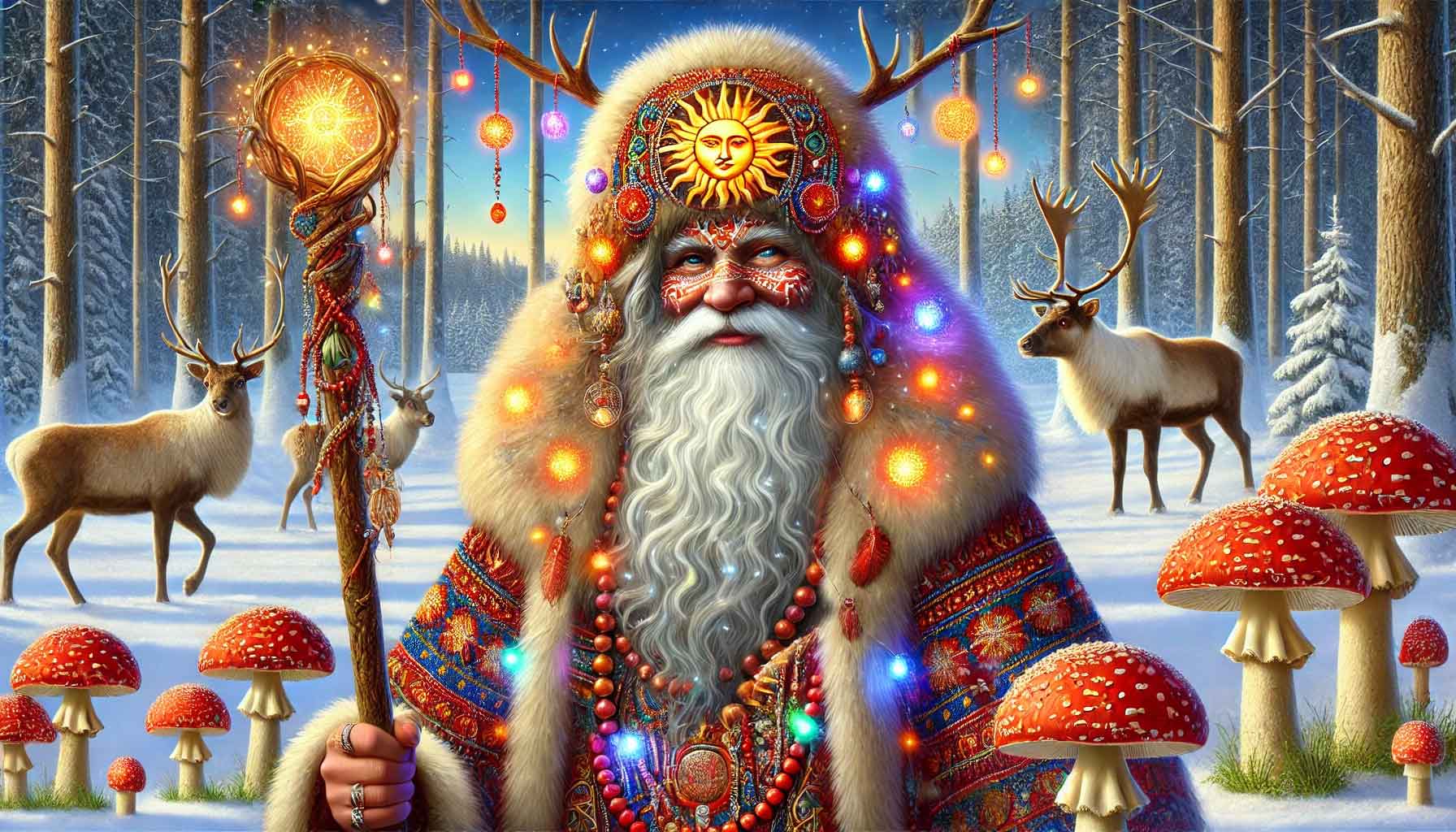

18 Responses
Thank you! Enjoyed learning many new things regarding CHRISTMAS AND Santa!
Nick
Thanks for all that. Of course there are elves. goblins and fairies My father used to see them long ago when out night fishing in Ireland. A yarn he told us as children was that coming home late one night he strayed into a fairy ring and the fairies were so annoyed they kept him there until morning.
I don’t think my mother believed him at all. Sometimes when we grow up we lose the magic
Slainte
Thanks for exploring the origins of Santa and sharing your research! Such an interesting and enjoyable read!
Unbelievable!! Thank you very much . Wonderful anthology of this holiday. Love it. You always provide great content. Thanx again
FUN FACT: Mithra is very likely taken from Mitra in the Veda. The Veda, which are the eternal “hymns” of Nature — not man-made and not “of this world” but are the “blueprint” of creation according to Maharishi Mahesh Yogi. In the Veda are the names Mitra and Varuna together. These are the devas, which the closest interpretation into English means “gods” but has no equivalent in Western cultures. Mitra and Varuna are known as Ādityas, which means they are sons of Aditi. Their relationship symbolizes a strong bond of friendship and loyalty, and they represent complementary aspects of cosmic order and morality. Together, they uphold the concept of Ṛta, the natural order and truth, and are often invoked as a pair in rituals and hymns. Thus, the connection to “he knows when you’ve been good or bad, so be good for goodness sake.”
That is very interesting research done on Christmas and its symbols. I did my own research a few years back and decided that I did not want to celebrate Christmas anymore. Christmas has its origins in the occult and in worship of other gods. I worship the one true God and he doesn’t want me to worship any other god or have anything to do with another god.
Pamela, you are correct. God has His own Holy Days that we are commanded to keep.Leviticus 23 of the Bible.
I love the symbols and the stories. That the stories have been handed down for generations makes me feel part of the lineage, part of the whole. I hope we continue to be open to all the stories and continue to share them.
as serious Bible students, Jehovahs witnesses have researched all the holidays and have chosen not to celebrate them for many years…we are very aware of where the many customs of the christmas celebration came from..the Bible tells to worship in spirit and truth so we do not do any part of Christmas
I love this sooo much, Nick! Thank you!
I became aware of Terence McKenna in 2016 while eating lunch with a group in Sedona, Arizona (wrote about that surreal experience in my blog if anyone is interested). So, for you to include an interlude of his in this post was glorious and unifying for me!
As well, so much about Santa connects for me since I have Dutch, German, and Irish roots! I love trees, so there’s that. I now live in New Hampshire, close to Massachusetts (which didn’t celebrate Christmas for many years back in the Puritan era). And I love Ireland and all their verbal stories of faeries and elves (since visiting twice in 2019)!
Merry Christmas!
What a wonderful blog- I love it.
Thanks so much.
I will still wish you all a Merry Christmas, personally, we celebrate Yule/Solstice but it is all the same, love and warm well wishes for this lovely season
Christ’s entrance into our physical world is the heart and soul of Christmas, and is the reason for the beauty and glory of this season, whether we recognize Him or not. Santa Claus, as part of the celebration, to me simply represents the spirit of love and giving. The minutiae of the origins of Santa, tree, etc pale by contrast!
Thank you for the interesting and fun read.
Last winter I saw some Amanita muscaria in a tree-box located on a commercial street next to my doctor’s office. Having never seen them up close and personal before, I was fascinated by them. I took pictures so I could ID them when I got home. My follow-up visit three days later they were gone, (harvested?), with no trace showing they’d ever existed there. They ARE mushrooms. It’s now the rainy season. I’ll bet they’ll be baaack. My only interest in them is: how on earth did they manage to evolve to look so amazing like that?
Nick, thanks so much for this fun, interesting article. An enjoyable Christmas read!
Dear Nick, Thanks so much for this wonderful article on both ancient and modern traditions of Winter. I had never heard about the link to Aminita mucaria, but am familiar with them and Terence McKenna. I also believe in the unseen world, or worlds, but have never seen any Elves, except onscreen from the imagination(?) of Peter Jackson. I’ve always been a big fan of interesting plants and I loved taking your course “Healing Kitchen: Let Food Be Thy Medicine.” The pictures you displayed in this article are fantastic, especially of the Sun God Mithra.Thank you for publishing this very informative article, and may You and Yours receive many Bright Blessings this Winter!
Fabulous! What an outstanding gift for this time of year. You and your research has provided insight into this season of many forms, historical tradition, and encourages our continued mind expansion.
I am ever so grateful that I am a part of this fruitful tribe.
Blessing of joy and peace to you and yours as we move forward into 2025.
I don’t celebrate Xmas, I’ve known along time it’s a pagan celebration, of the sun god, though I thought it was solar. This has been a very interesting read. When you think that Jesus died at age 33 1/2 around about April ( easter -another pagan celebration) count 6 months Jesus would have been 34 yrs old which brings you to October. The truth isn’t hard but it’s whether the veil drops from our eyes so that we can ‘see’ did you know santa is an anagram of satan. Also if we were ment to celebrate tradition wouldn’t God have had it written in his manual for mankind, the Bible? Psalm 83:18
Great to read and inspired by the references provided. Good to know also and expand our world and consciousness. In any case, there is glory, wisdom and beauty there! Thank you, Nick. maria a.a.